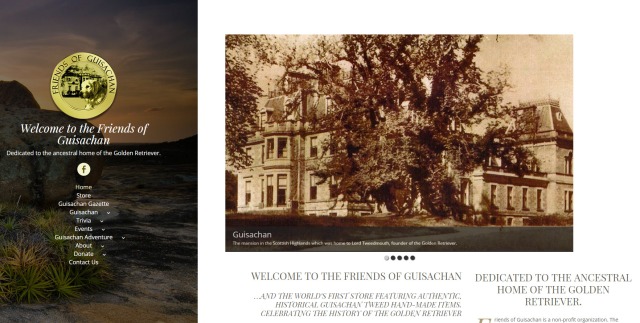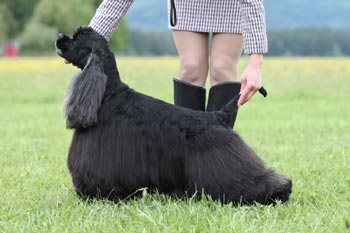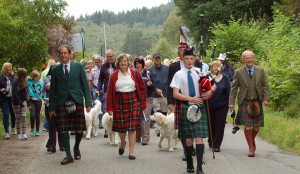Coming soon: https://friendsofguisachan.org/main
A Good Source for a Great Breed
A non-profit group has made the history of Golden Retrievers it’s business…
https://friendsofguisachan.org/main/

STATUE UNVEILING
The piper and the parade stopped at the memorial to Lord and Lady Tweedmouth to pay tribute to the founder of the Golden Retriever.
Tweed Water Spaniel Revisited
The Tweed Water Spaniel is a mysterious breed. It is very probable that this was a water dog/retriever that resided and hunted along the Tweed River. I am inserting previous blog posts to revisit…
This is from: “The complete farrier, and British Sportsman” By Richard Lawrence (veterinary surgeon.) – dated: 1816
Tweedside Water Spaniel
I was reading a book this morning that had reference to a Tweedside Water Spaniel. The author was giving his own account as to the value of a good retriever in the Highlands of Scotland. He differentiates between the Irish and the Tweedside so they must have had their differences which makes the image of Belle in the Guiaschan photo even more plausible.
In pheasant shooting two varieties of the dog, not already treated of, are used—the cocker or spaniel, and the retriever. Both may be used with advantage in other kinds of shooting, the retriever being invaluable, and far too little employed by sportsmen. The retriever, as his name implies, is simply any dog which recovers and fetches game when killed, as some pointers and setters do by nature, while others of these varieties are so taught, especially on the Continent. This is an accomplishment, however, these breeds are much better without. But a proper retriever should be a powerful dog, patient, and quite under command, and never leaving your foot until told to do so. The Irish and Tweedside water spaniels make good retrievers, but want power, to secure which a cross with a genuine Newfoundland dog is recommended. A perfect retriever must possess a good nose, strength, and steadiness, and must take to water freely—acquire these qualities by any manner of breeding whatever. He must besoft-mouthed, i.e., he must not injure game while carrying, but, like Isaak Walton with the frog, use them as though he loved them. The produce of a strong Newfoundland dog with a gentle-tempered setter slut is as good as can possibly be advised. Such will both hunt covert well, doing quietly the work of a dozen noisy boys, and retrieve wounded and dead game successfully through goodness of nose derived from the dam.But as good and bad qualities in dogs are hereditary, the young sportsman need not pay particular attention as to how the good qualities have been obtained by crossing, provided that they are there, and cannot do better than purchase the progeny of proved parents, regardless of the breed—this being quite a different thing from setters or pointers, which have a certain specific and instinctive work to do, independent of general sagacity. Retrievers are seldom thoroughly trained until two years old; they cannot be broken-in at once like the pointer—hence the best are those which have followed a keeper’s steps from puppyhood, and their price is high when perfect in all their parts. In fact, no dog is so valuable to the sportsman, yet, notwithstanding, they are not used to nearly the extent they deserve. A retriever saves time, game, money for beaters, and also saves labour in trapping, by recovering dead game which would otherwise be lost, and serve for food for all sorts of running vermin, which are thus drawn into ground where retrievers are not used.
“Scottish field sports: a volume of mingled gossip and instruction” – By James Dalziel Dougall 1861
History is as good as what is recorded….
There is no mention of the Tweed Water Spaniel in the Guisachan stud book. There is a note on the cover page that was later added that reads: Tweed over the words Water Spaniel.
When you read the description of the Tweed Water Spaniel that hunted along the Tweed River, the assumption that there was Tweed Water Spaniel within the breed, is a good suspicion. It is not, however, written in the stud book. Ladykirk bred gift from D. Robertson does not translate to Tweed Water Spaniel. Wouldn’t it be nice if someone could find records for Ladykirk’s dogs. That would most definitely clear up the matter very nicely.
Elma Stonex believed so firmly that Belle was a Tweed Water Spaniel that she wrote that she was listed that way in the stud book. Belle simply was not listed as anything other than a retriever. I have looked through the pages up and down and she most definitely was not classified as a Tweed Water Spaniel. I think that Elma Stonex was verbally told this and saw the note and so believed. It is not a bad belief but someone needs to set the record straight about the stud book. Otherwise it all becomes propaganda. We do not want that. Verbal historical record is very valuable and it should be recorded that way. Altering historical artifacts is not the way to go.
Another Myth Busted…
There has been a rumor going around that Dudley Coutts Marjoribanks was not Lord Tweedmouth but rather Baron Tweedmouth.
Well, the fact is that he was both and referred to as both.
He was a part of the House of Lords in parliament (Lord) and he was a land owner (baron.)
People get confused when someone who owns a great amount of land is referred to as Baron. They think of that as a title like Lord but is just referring to the land owned.
My great grandfather was a baron but he was not part of royalty or any praliament. He simply owned quite a bit of land.
Dogs of Purpose
I was reading through a few books from the 1800’s to get a better feel for the dogs and thinking that went into the creation of today’s retrievers. Well, clearly I have been doing this for a few years and that is how this blog came about… I found that there was a huge leap from the early to late 1800’s as far as dog breeds. I smile when I see the ancestor of the Springer Spaniel referred to as the Springing Spaniel in 1829 and also can’t help but notice that the Spaniel in general at that point in time ranged in size from the very tiny to the very large St. Bernard.
By the 1870’s, guns had a longer range and the need for the retrieving dog became such that there was a real quest as far as crossing to find the best mix to do the job.
At that point int time there was already established the Retriever Proper but that retriever was not quite right yet. The addition of the Spaniel which was being used when the game was small enough was missing. Of course except for in a couple of instances such as Lord Tweedmouth’s dogs who had the addition of the Tweed Water Spaniel.
In the book “Dogs: their Sagacity, Instinct, and Uses,” George Frederick Pardon (1877) writes that a retriever proper is a mixture of an Irish Water Spaniel and a Newfoundland. This retriever has a large eye and capacious mouth. His ear smaller with shorter fur close to the head. His nose very large and his neck long and his shoulders oblique and deep and his chest very broad and powerful. The loins, back, and hind quarters strong for the carry especially over a stone wall. His legs long, straight and muscular with round moderate feet well arched. His coat flat, shining and abundant unless needed for punt shooting where it should be short. Tail should be well feather and moderately short and carried gaily. The feather should taper.
He writes that the temper is the foundation of a good retriever and needs to be good. He should be 24 inches at shoulders, moderately long in the body. The setter cross is best but may cause a problem with liking water. “An English Retriever, whether smooth or curly, should be black or black and tan, or black with tabby or brindled legs, which are indicative of it’s Labrador origin. Preference is given by many to the flat-coated or short-coated small St. John’s breed. It has a marvelous intelligence, a great aptitude for learning, a good carrier; with a soft mouth, great strength, and thorough liking for swimming.”
He goes on to say that at times he prefers the spaniel as a retriever since his nose is keener but the spaniel is limited on game size to retrieve. the spaniels he mentions are:the Golden-liver Sussex and the Norfolk Springer. A problem with using terriers is that if they have been used for ratting that they would tear apart the game.
And so it is only a matter of time that hunters would perfect their retrievers with the addition of the spaniel, a dog that on it’s own made a great retriever and who had a better nose than the Irish Water Dog.
So what was the Spaniel? This term was used for many years but it was a very open term. There were little lap spaniels and big St. Bernard Spaniels. Dudley Marjoribanks bred in a now elusive spaniel called the Tweed Water Spaniel which we know mostly from writings about it residing along the Tweedmouth River.
Biographical sketches and authentic anecdotes of dogs , Thomas Brown
1829
Dogs: their sagacity, instinct, and uses, George Frederick Pardon
1877
Old to New
…and hopefully back again!
Can we return to something more practical?
Cocker Spaniel in 1903:
 Cocker Spaniel? (Dust Mop!!!) today:
Cocker Spaniel? (Dust Mop!!!) today:
 Which one would you want as a working companion? Which one would you want as a pet?
Which one would you want as a working companion? Which one would you want as a pet?
The photos don’t show a very important difference in these dogs. The earlier dog has an even temper along with drive in the field. The today’s version will bite you!
What can we do to reverse this?
Can we stop the Golden Retriever from succumbing to all these same bad practices of breeding for the show ring? The Golden is not supposed to be blocky headed. The Golden is not supposed to be big boned. The Golden is not supposed to have massive amounts of fur. The Golden is not supposed to be a large dog. It is supposed to be moderate.
What is a Breed?

The Encyclopaedia of Sport, Volume 1
Front Cover
Henry Charles Howard Earl of Suffolk and Berkshire, Hedley Peek, Frederick George Aflalo
Lawrence and Bullen, 1897
What is a breed? We humans want to classify everything in life in order to control it enough to examine and understand within our given abilities each item. In the case of dogs, breeds have gone beyond a dog’s color and abilities. Breed descriptions have become rather rigid and allow us to better understand dogs within each breed by simplifying the attributes allowed to be bred. Our very simple minds can more easily handle a cookie cutter dog type than to allow a more organic progression of dog breeding. Because of our human short shortsightedness and limited information processing abilities, we have institutions such as the AKC and events such as the Westminster or Crufts.
When the above article was written regarding the Retriever, the specialized retrieving dog was a newer concept. There were many sportsmen breeding various combinations of dogs to retrieve and the sport of breeding that perfect dog was quite a contest.
Today, because of our human need to have the AKC and similar registries, retrievers have been placed into very specific and rigid categories. Like children who don’t want there peas and carrots mixed up with their mashed potatoes, dogs from these various categories are not allowed to breed to one another. They must remain “pure.” Since the breed is controlled in this manner, our dogs are not very healthy and do not live very long lives.
Having breeding standards for health including functional structure is a good thing. Can true health be found within these rigid registries?
When I watch the Westminster, it’s the extreme dogs that draw attention however, all these dogs could be healthier and better off if they were bred more responsibly. Breeding responsibly means not breeding for the breed ring win.
“English Retriever”
| Title | Outing: Sport, Adventure, Travel, Fiction, Volume 35 |
| Publisher | W. B. Holland, 1899 |
A retriever’s purpose…
Fetch and carry: a treatise on retrieving
By Bernard Waters
1895
This book written just before the turn of the 20th century, is largely about how to train and hunt with a retrieving dog. The Chesapeake Bay dog that is illustrated looks very “setterish” to me . It also shows a prized black retriever that looks like it has a bit of white on it’s chest if you look closely.











